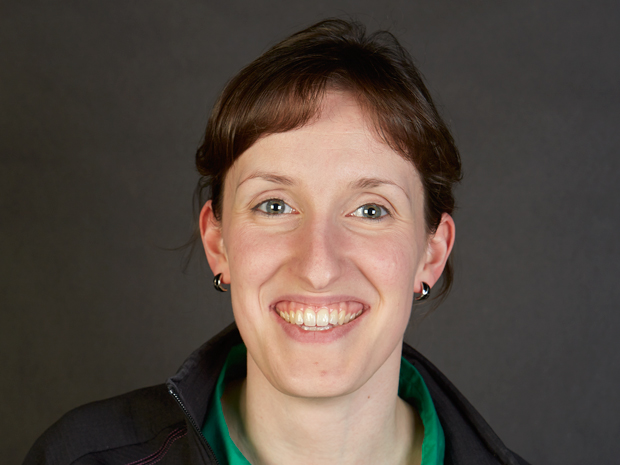
Let there be light
With topics ranging from how microbes influence our lives to the storage of data in DNA, EMBL Heidelberg hosted a unique brand of seminar in 2014 that gave young researchers the chance to give a popular science lecture on the big stage.

Organised by outreach officer Angela Michel, the Sunday Matinee series Mehr vom Leben (More from Life) saw more than 1300 visitors fill the EMBL Advanced Training Centre to learn about the incredible work being carried out by EMBL fellows. Concluding the series was a talk on the evolution of photoreceptors by Silvia Rohr, a PhD student in Detlev Arendt’s group.
What was the key message you wanted to deliver?
Light is very important for us – in science, philosophy, culture and more. It irradiates the universe, illuminates how we see the world and is central to our own existence. The human eye is beautifully complex, and acts like a camera to collect and focus light. It converts this into an electrical signal that our brain then interprets into an image of the world in front of us. Evidence suggests that our eye evolved from a simple light sensor, and present-day primitive sea creatures hold important clues for understanding this process. Indeed, some of their features resemble the ancestor from whom we all evolved and in which photoreceptors initially developed. In a sense, we are all sea creatures – we depend on the oceans to provide our food and regulate the Earth’s climate – but the ocean also holds secrets to our past and how we came to be.
I am fascinated by what is out there, what it all does and why it is as it is.
Why do you do what you do?
Charles Darwin wrote in the Origin of Species that he was perplexed by the complexity of the eye – its functions, architecture, and how it works – yet he remained convinced it evolved in the manner he proposed. In recent years we have learned a lot more about the evolutionary steps that have occurred, particularly by comparing eye structures and genes across species to understand when key traits arose. But there is much more to learn. For me personally, the most striking aspect is the sheer diversity of light perception that is evident in animals, depending on where they live, what they do, and how they have adapted to their environment. Some insects, such as flies, have compound eyes made of thousands of hexagonal compartments, or ommatidia, that comprise a corneal lens, a crystalline cone and a light-sensitive organ at its base, all working in unison to deliver a picture of the world. The octopus, on the other hand, has camera-style eyes that at first glance resemble our own, but in reality its photoreceptors are more like those found in insects. The functions of different styles of photoreceptors vary between vertebrates and invertebrates, and can impact on day and night vision – for example, geckos can distinguish colours in dim moonlight, whereas humans are colour blind. There are countless examples of such diversity in nature and I am fascinated by what is out there, what it all does, and why it is as it is.
What are you personally working on?
I am defining the different types of photoreceptor cells in a fish-like marine chordate called amphioxus, which is usually found in shallow sands in temperate and tropical climates. Amphioxus has a very simple brain uniting invertebrate- and vertebrate-like features, and we believe its appearance has not changed in more than 500 million years. I am using modern molecular biology approaches, such as cell-type molecular fingerprinting, to try to understand the differences and similarities in photoreceptors between various species, including amphioxus, the marine annelid Platynereis dumerilii and the sea anemone Nematostella . By comparing species we can begin to ask questions such as: how did the first photoreceptor cells emerge? What was their function? Which environmental pressures push photoreceptors to take on new roles? We are a long way from understanding all the phenomena we see in nature, but even these initial steps are very exciting.
What is a typical week like for you?
In the summer months we plan our days – experimental work, caring for the animals and cleaning the tanks – around animal spawning, which happens one hour after an artificial “sunset” at 1pm each day. In winter, I spend more time at the bench as well as reading books and papers. We make occasional trips to find new animals at sea: some we locate easily, others are more like a treasure hunt that involves identifying possible habitats, travelling out there by boat, bringing up samples from the sandy water, and sieving through the contents. Often you can go days without finding anything at all, but when we finally locate the creatures we are looking for, it’s all worth it.
I realised that people other than scientists actually find my work really interesting
Did the experience of giving a popular science lecture change the way you look at your own research?
It was a fantastic opportunity to share my passion for this subject with a large public audience – I would certainly do it again. I was impressed by the connections members of the audience made between this and other research areas, such as the evolution of the brain, and the role of photoreceptors in plankton. I realised that people other than scientists actually find my work really interesting. Many of my friends came to the lecture or watched the live stream because they wanted to know more about it. As we learn more about the ocean, it’s like discovering a second world within our own. It is fascinating to think about what’s been going on down there over the course of hundreds of millions of years, what is going on down there today, and what is still left to discover.


